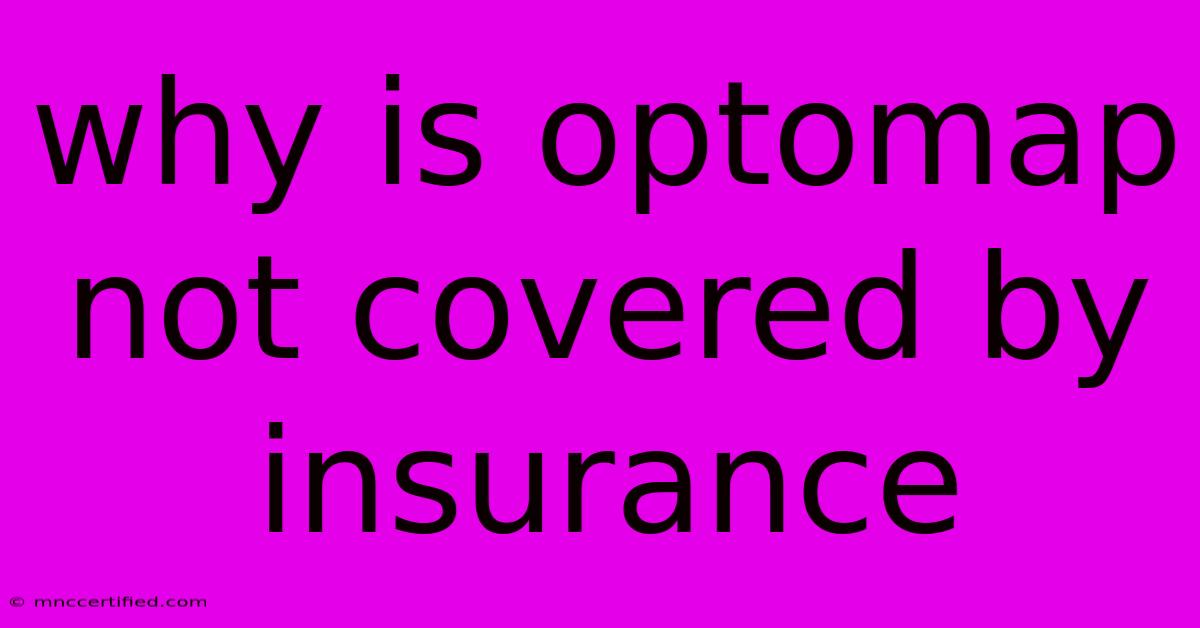Why Is Optomap Not Covered By Insurance

Table of Contents
Why Isn't Optomap Covered by Insurance? A Comprehensive Guide
Optomap, a specialized retinal imaging technology, offers a detailed view of the back of the eye, aiding in the early detection of various eye diseases. While its benefits are undeniable, many patients find themselves facing hefty out-of-pocket costs because their insurance doesn't cover it.
This article aims to provide clarity on why Optomap isn't always covered by insurance, exploring various factors at play.
Understanding Optomap and Its Benefits
Optomap uses a non-invasive imaging technique to capture a wide-angle view of the retina. This allows eye care professionals to assess potential problems like:
- Diabetic retinopathy: A leading cause of vision loss, characterized by damage to blood vessels in the retina.
- Macular degeneration: A degenerative eye disease affecting the central part of the retina, leading to blurry vision.
- Glaucoma: A condition that damages the optic nerve, potentially causing blindness.
- Retinal tears and detachments: Serious conditions requiring immediate treatment.
Early detection of these eye diseases is crucial for successful treatment and preventing vision loss. Optomap helps identify issues even before symptoms appear, making it a valuable diagnostic tool.
Why Insurance May Not Cover Optomap
Several reasons contribute to insurance companies' reluctance to cover Optomap:
1. Lack of Medical Necessity: Insurance companies often require medical necessity for coverage. While Optomap is valuable for early detection, some argue that its use isn't always medically necessary in routine eye exams, especially for individuals without known risk factors for eye disease.
2. Cost Considerations: Optomap is a more expensive technology compared to traditional eye exams. Insurance companies aim to manage their costs and might consider Optomap as an unnecessary added expense, especially if it doesn't significantly improve the overall cost-effectiveness of care.
3. Lack of Standardized Guidelines: There are no universally accepted guidelines for when Optomap is medically necessary. This lack of consensus among medical professionals makes it difficult for insurance companies to establish clear coverage criteria.
4. Technological Advancements: Traditional eye exams and other diagnostic tools continue to evolve, potentially providing comparable information at lower costs. Insurance companies might prioritize coverage for more established and cost-effective technologies.
5. Individual Policy Variations: Insurance policies vary widely in their coverage for diagnostic tests. Some policies might include coverage for Optomap, while others may exclude it or require specific pre-authorization processes.
What You Can Do
1. Speak to Your Eye Doctor: Discuss your concerns about Optomap coverage with your eye care provider. They can help you understand the benefits and risks associated with Optomap and determine if it's medically necessary for you.
2. Check Your Insurance Policy: Carefully review your insurance policy to understand your coverage for diagnostic testing, especially for eye exams. Look for specific details regarding Optomap or retinal imaging.
3. Seek Pre-Authorization: If your policy requires pre-authorization for certain procedures, contact your insurance company to request pre-authorization for Optomap. This can help you avoid unexpected out-of-pocket expenses.
4. Consider Alternative Options: If Optomap isn't covered by your insurance, explore alternative options for retinal imaging. Depending on your needs and your eye care professional's recommendation, there might be less expensive alternatives available.
5. Advocate for Change: Advocate for increased insurance coverage for Optomap. Contact your insurance provider and your elected officials to express your support for expanding coverage for valuable diagnostic technologies like Optomap.
Conclusion
While insurance coverage for Optomap can be a barrier for many, understanding the factors at play and proactively engaging with your eye care provider and insurance company can help you make informed decisions about your eye care. By advocating for wider coverage and exploring all available options, you can ensure access to this valuable technology and potentially benefit from its early detection capabilities.

Thank you for visiting our website wich cover about Why Is Optomap Not Covered By Insurance. We hope the information provided has been useful to you. Feel free to contact us if you have any questions or need further assistance. See you next time and dont miss to bookmark.
Featured Posts
-
Bo E Cuts Interest Rates New Rate Is 4 75
Nov 08, 2024
-
Hamas Sacrificing Palestinian Well Being
Nov 08, 2024
-
Fidelity Investments Westlake Tx Address
Nov 08, 2024
-
Septa Strike Could Force Philly Schools Online
Nov 08, 2024
-
Can 23and Me Survive The Dna Testing Race
Nov 08, 2024